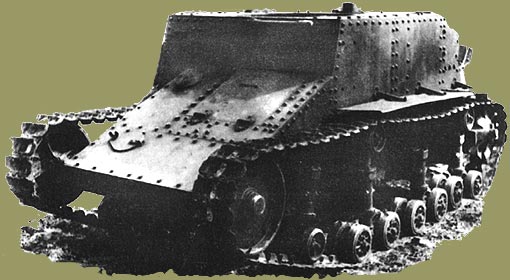T-21 and T-23 Tankettes
 T-23 Tankette. (M.Kolomiets)
T-23 Tankette. (M.Kolomiets)
In 1929-1930's a project of tankette T-21 is started, becoming a logical continuation of T-17 Tankette. T-21 was classified as a "Small Reconnaissance Tankette", and closely resembled T-17, except that it had two-man crew, increased armor (13 mm) and support wheels from T-18 Escort Tank. The engine of power 20 h.p, and transmission were borrowed from Т-17. However at this stage of development, its estimated speed of its movement and the characteristic of overcoming obstacles appeared insufficient; so the project wasn't authorized.

Initial project of the T-23.

T-23 Tankette that was actually built.

T-23 Tankette. (M.Kolomiets) |
In 1930, on an assignment of RKKA headquarters, and considering experience with T-17, works begin on a new two-men crew tankettes T-22 and T-23, classified as "large reconnaissance tankettes". Their difference was in the engine: T-22 was planned with original four-cylinder engine, and T-23 with the engine from tank T-20. Also, the difference was in location of crewmembers: on T-22 they were placed one after another, and on T-23 - in a row. Each project had its own strengths and weaknesses, but T-23 was chosen for production, as more economic and simple to build. First prototype of T-23 had a hull of simple metal and engine from T-18 (40 h.p.), but for second prototype a special modified engine of not yet finished T-20 was used, and four more were ordered. All tankettes were produced on 2nd Automobile Factory VATO (director - S.F. Ivanov), and works on T-23 were carried out in surprisingly short time and good quality.
During the production, tankette underwent countless technical modifications, which had almost completely changed it. Its length was increased by almost 300 mm. Instead of basic and supporting wheels from Т-18, those of Т-19 tank were used. A new facilitated track, with a new driving wheel was implemented, as old ones did not provide a speed of 40 km/h. However, even with the involved improvements, the tankette was unsatisfactory, since its price was almost that of the tank T-18, and in a version with a turret, even surpassed it (over 59 thousand rubles without armaments!), which did not allow for its mass production in required numbers. If the three-year program on support tanks had even surpassed its plan, for tankettes it was not even completed, which made it necessary to purchase a license for production of British tankette "VCL" (Vickers Carden-Loyd) to satisfy GUVP executives.
Translated by:
Pavel Poljakov
Sources:
A.Beskurnikov, M.Svirin, "Pervye Sovetskie Tanki" Armada #1. |
J! Reactions Commenting Software
General Site License
Copyright © 2006 S. A. DeCaro |








